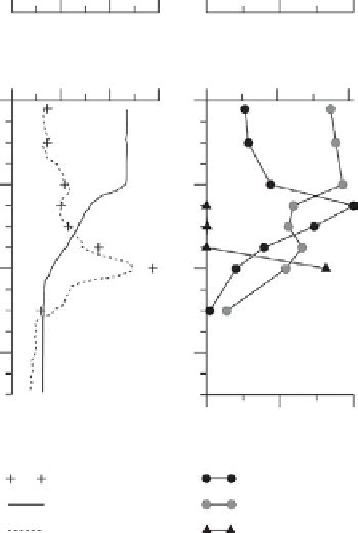Geoscience Reference
In-Depth Information
Figure 7.13
Observations from a site in
the Celtic Sea show (a) a typical
summer stratified water column, with a
SCM towards the base of the
thermocline. Analysis of water samples
(b) illustrates how the SCM profile is
made up of signals from different
phytoplankton groups (expressed as
cells
10
3
ml
1
). The distribution of
the phytoplankton groups is consistent
with their photosynthetic pigments
and the changes in the light spectrum
with depth. (Adapted from Hickman
et al.,
2009
, with permission from
ASLO; data courtesy of Anna
Hickman, University of Essex).
(a)
(b)
Temperature (°C)
Picoeukaryotes
12
16
0
3
6
8
20
Chl (mg m
-3
)
Synechococcus
0
0.5
1
1.5
0
70
140
0
-20
-40
-60
0
0.5
1
Diatoms
Chl
a
samples
Temperature
CTD Chl
a
Synechococcus
Picoeukaryotes
Diatoms
cosmopolitan in composition. The relatively quiescent, low nutrient regime tends to
favour smaller cells (small dinoflagellates and flagellates, cyanobacteria). Diatoms
are also sometimes seen, mostly at the base of the thermocline. We might conjecture
that diatoms arise in response to short-term mixing events that temporarily alleviate
the nutrient stress, though sufficiently long and well-resolved time series of the
thermocline phytoplankton community that might allow testing of this hypothesis
do not exist. The slight negative buoyancy of diatoms would lead to their being
preferentially found in the lower thermocline. Also, Lagrangian modelling of diatom
trajectories has shown that cells, replenished by nutrient uptake in the bottom layer,
are transported by bottom layer tidal turbulence into the base of the thermocline,
but with their lack of motility preventing them from reaching further upward they
(see
Fig. 7.12b
). Phytoplankton species have also been observed to be layered
within the SCM in response to vertical changes in the spectral properties of light,
as shown in the example from work in the Celtic Sea shown in
Fig. 7.13
(Hickman
From an observational point of view we identify phytoplankton layers as 'chloro-
phyll' maxima primarily because of the ease of observing chlorophyll fluorescence.
However, the ecology of these layers is far more complex than our simple observa-
tions of chlorophyll might at first lead us to believe. Turbulence, current shear, cell




Search WWH ::

Custom Search